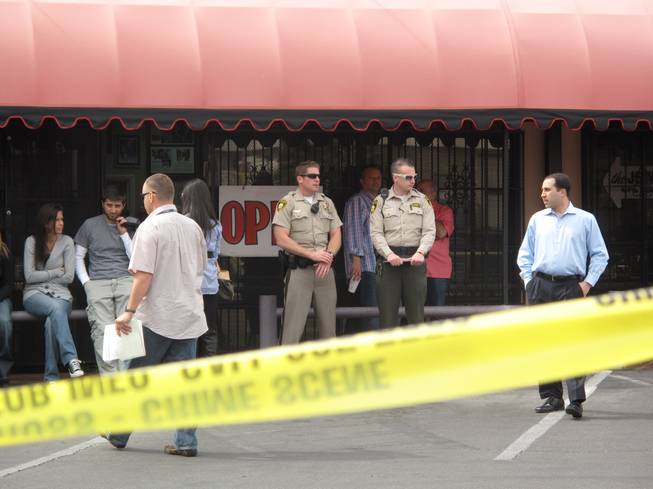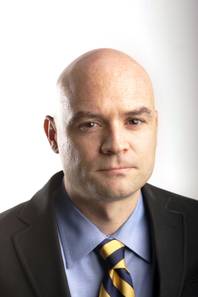
Metro Police investigate a robbery and shooting Friday, April 2, 2010, at a jewelry store in the 2400 block of Western Avenue.
Tuesday, June 18, 2013 | 2 a.m.

J. Patrick Coolican
Sun coverage
Since 2010, the worst types of violent crimes, including homicides and assaults with weapons, have been on the decline in the Las Vegas Valley.
And the Las Vegas Metro Police Department has been particularly adept at investigating murders, with more than 75 percent of cases leading to an arrest, well above the national average of 65 percent for departments of similar size.
Buried within the data, however, is a troubling fact. In nonlethal shootings, when the victim survives, the criminal is more than 90 percent likely to get away with the crime, according to data supplied to me by Metro.
In 2012, for instance, there were 313 nonlethal assaults with firearms. Just 20 of the cases led to an arrest. Although the number of these incidents has declined 9 percent since 2010, the pattern of investigative failure has remained largely unchanged, with just 7 percent of all nonlethal shootings leading to an arrest since 2010.
In the past three years, 917 incidents of nonlethal shootings — 93 percent — remain unsolved.
Metro spokesman Bill Cassell told me that homicides, as opposed to nonlethal shootings, can be easier to solve. First, a corpse and a murder scene offer certain investigative advantages over, say, a highly dynamic drive-by shooting when the victim survives. The victim in a nonlethal shooting may also be uncooperative, fearing retaliation for talking to police or wishing to settle matters himself.
Also, Cassell said, in most homicides, the victim has some relationship with the killer. That in turn helps investigators narrow the number of suspects.
(Criminologists threw cold water on this explanation for fewer arrests in nonlethal cases. Why, they ask, would a victim who survives a shot to the shoulder be any less likely to know the perpetrator than a homicide victim?)
Eugene O’Donnell, a former New York City police officer and now a criminologist at the John Jay School of Criminal Justice at City University of New York, said Metro is not alone in its failure to solve these crimes. Other large, urban departments have faced similar struggles.
Still, he said, it’s a glaring failure of basic policing.
“What's a police department for if not to solve gun violence?” he asked.
As O’Donnell noted, the only reason these shootings do not result in homicides is sheer luck — the perpetrators are poor marksmen and/or advances in traumatic medical care saved the victims.
Given the ongoing scourge of gun violence, O’Donnell said these shootings should be treated with the same investigative zeal as lethal encounters.
“It should be treated like homicide, and they should flood the zone when it happens,” he said.
O’Donnell said the failure to solve the shootings and make arrests erodes any potential deterrence: “You can pretty much bet you won’t get caught. Bad guys know this. Undoubtedly, some are repeat offenders.”
Other criminologists contacted by the Sun were surprised by Metro’s low arrest clearance rates, wondering whether the total number of shootings reflected police merely responding to “shots fired” calls.
Cassell clarified for the Sun that a “nonlethal assault with a firearm” does not include officers responding to a “shots fired” call. The incident only qualifies once an officer has investigated and determined there’s been a shooting with a victim.
Franklin Zimring, a UC Berkley criminologist and an expert in crime data, offered a blunt assessment of the discrepancy between homicide and nonlethal shooting arrest rates in police departments across the United States: “They don't care as much. So they don't invest resources in it.”
Metro’s Cassell replied: “We would love to have the resources to investigate with the intensity we do with homicide. In this economic environment, we simply don't have those resources.”
In recent years, Metro has eliminated 506 positions: 238 officers, 236 civilians and 32 temporary positions.
O’Donnell said a lack of investigative focus on these nonlethal shootings has become all too common.
One potential problem is that many police departments do not track nonlethal shootings. Indeed, Cassell said that to retrieve the data I was seeking, Metro analysts had to extract the numbers from other data sets.
The FBI’s Uniform Crime Reports — the widely used data that police departments and policymakers use to compare crime from one year to the next and between jurisdictions — do not have a category for nonlethal shootings. Instead, aggravated assault is used to measure serious assaults; police arrest someone in about half of those cases.
O’Donnell said this is a flaw in how we measure crime. He also said there’s a disturbing — and baffling — lack of attention from the media and criminologists in academia on issues of basic policing.
“When people present themselves and say, ‘I was shot in the shoulder,’ how are you doing on those cases? That should be measured. For some reason, it doesn't get a lot of attention,” he said.
Last year, the Newark Star-Ledger used public records requests to compile data on arrests in nonlethal shootings in New Jersey’s nine most violent cities. The paper found 2,593 nonfatal shootings in those cities from 2008 to 2011, with nearly 2,000 — or 75 percent — unsolved.
After the paper’s story was published, Newark Police Director Samuel DeMaio created a detective squad to focus solely on nonfatal shootings, acknowledging the need to invest more resources: "It’s kind of common sense. If you’re closing more shootings and you’re arresting the people that are doing the shootings, your numbers are going to go down."
Cities with detective squads that focus on nonfatal shootings — including Paterson, N.J., and Baltimore — have seen higher arrest rates, around 50 percent.
I realize Metro has struggled through budget cuts these past few years, but nearly 1,000 unsolved gun crimes in the past three years is far too many.


Join the Discussion:
Check this out for a full explanation of our conversion to the LiveFyre commenting system and instructions on how to sign up for an account.
Full comments policy